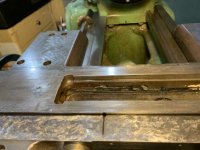What month was this 1940 10ee produced? Is it MG powered? or is it the Sundstrand? Hydraulic drive lathe?
All I remember is early 1940. I’ve had it 26 years now, it was the first machine tool I purchased over the internet, from Anchor Machinery in Port Orford, OR. It has a Sundstrand hydraulic drive. The only part that is not original is the motor, which was a 440V 3-phase motor. I replaced it with a GE 3HP single phase motor, which is perfectly suited to the machine.
I had the metering units cooking in the ultrasonic cleaner all night, so I will test them and see if they have a good flow, then put them back in service.j. The front v-way was only getting about 1/10 as much oil as the rest were producing, so I’m hoping the cleaning solved that problem.
Once the saddle is sorted, I plan to remove the apron and clean the oil sump and replace the pump filters. Since the apron and saddle will both be off, it would be a good time to scrape the green paint off and see what is left of the original dark blue grey. I started the overhaul at the beginning of January, so a lot has already been done (alignment checked, cross slide scraped flat and perpendicular to the spindle, DRO fitted including milling a flat spot on the saddle where the reader head gets mounted, wipers replaced, oil grooves cut in the cross slide, underside of cross slide relieved .010”, gib fitted with a .007” shim epoxied to the back, ...). Other than cosmetics, the only thing left to address is the tailstock quill. My plan is to get it hard chromed then hone the bore to fit, then scrape the bottom and shim between the top and bottom, so there is some work. One other thing I am considering doing is replacing the taper attachment with one from a later lathe. They changed the taper attachment design in 1941, and the later design has one advantage: you can fit a long cross slide to the machine. The early design gets in the way. I have a later cross slide (from a 1942 machine) that has the rear toolpost. That’s a nice option to have, but the primary motivation is that the sliding surface is 4 or 5” longer, just like the later lathes. I’ve already scraped and fitted both cross slides, its just a matter of should I keep the machine original, or not.














